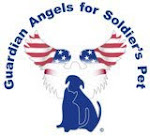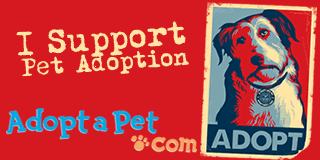This article kicks off my soon-to-be posted series on soldiers and dogs. There are so many organizations taking advantage, finally, of the bond that forms between dogs and soldiers, and how the dogs are helping soldiers heal from their wounds. Here is an article that shows dog and soldier are healing each other.
via Fred W. Baker III for http://www.army.com/:
Homeless Dogs Help Healing Troops
 Army Capt. Lawrence Minnis sits with his two adopted pit bulls at the Washington Humane Society’s Behavior and Learning Center, Nov. 12, 2009. Minnis met the dogs through the humane society’s Dog Tags program, in which soldiers recovering at Walter Reed Army Medical Center sign up to help teach animals housed at the shelter learn how to behave. DoD photo by Fred W. Baker III
Army Capt. Lawrence Minnis sits with his two adopted pit bulls at the Washington Humane Society’s Behavior and Learning Center, Nov. 12, 2009. Minnis met the dogs through the humane society’s Dog Tags program, in which soldiers recovering at Walter Reed Army Medical Center sign up to help teach animals housed at the shelter learn how to behave. DoD photo by Fred W. Baker IIIWASHINGTON (American Forces Press Service) – Lawrence Minnis never met a dog he didn’t like.“I want just about every dog I see,” the Army captain said with a laugh.
Minnis is especially fond of pit bulls, and he somewhat resembles his favorite breed -- broad-shouldered, stocky and muscular. He sat on the floor in the back of a classroom at a Washington Humane Society shelter here recently, stroking his adopted black pit bull, Ebony.
As happy and healthy as the two appear now, they met when they were both on the mend – Minnis from a near-crippling infection and Ebony from nearly starving and freezing to death. The two shared a companionship that helped them heal and ultimately altered the course of their lives.
Minnis met Ebony through the Humane Society’s Dog Tags program in which soldiers recovering at Walter Reed Army Medical Center sign up to help the shelter dogs learn to behave. It’s a program in which everyone benefits, officials said; the soldiers get out of the hospital and learn to care for and train the dogs, and the dogs learn better behavior, making them more adoptable.
“They’re really loving those relationships with the animals,” said Diana Foley, behavior and training counselor with the Humane Society. “It gives them a way to get away from Walter Reed. They can come here and interact with the animals.”
The program began simply enough more than a year ago. The shelter is located just across the street from the Walter Reed campus. Soldiers out walking would come across shelter staff members walking the dogs. They would stop and pet the dogs and seemed to enjoy getting to know them. Officials at the shelter had the idea to hook the two together through a training program for the troops and the dogs.
The society now offers two classes weekly that teach soldiers about dog behavior and training. Troops filter through the Georgia Avenue shelter learning the basics of dog behavior and how to read dog body language and train the dogs. The mix of hands-on and classroom training offers the troops enough expertise that they can use the skills as a launching pad for a career.
“We want the program to be educational so that if there are servicemembers in the program that want to potentially pursue this as a career, … they’re getting as much information as possible and as much hands-on time as possible with the dogs,” Foley said. “We also want it to be recreational, too, for people who … just love animals and like spending time with the dogs.”
The six-month program is split into three levels, ranging from beginner to advanced. In the beginner class, troops learn basic animal body language and obedience commands such as “sit” and “stay.” In the advanced classes, troops learn to evaluate the dogs’ temperament and how to begin working with aggression issues and separation anxiety.
The skills the dogs learn in the classes translate to better placement opportunities, Foley said. The program has far expanded the amount of training the shelter’s dogs received previously.
“This is another way our dogs are outside of their kennels being talked to and touched and interacting with people,” she said. “That’s extremely beneficial to reduce the stress levels of the animals in our kennels, and at the same time, it makes the animals far more successful in their new homes if they come into it with some basic obedience training.”
But for all of the good it is for the dogs, it is equally beneficial for the recovering troops, Foley said.
“It’s really just an outlet to be social with people and social with the animals and have time away from the hospital,” she said.
Foley described one soldier who came to the class who was having difficulty interacting with people. He didn’t make eye contact and kept to himself. Working with the dogs built his confidence and helped to bridge his shyness with the staff.
“It really helped him develop social relationships with people,” Foley said. “He went from being a very, very shy person when he first entered. [Now] he’s totally not that same shy person that he came into the program being.”
Some of the dogs are at the shelter for a few months, and many of the soldiers develop close relationships with them. Others develop friendships with the staff. Some soldiers remain on as volunteers at the shelter long after the classes end, Foley said. Minnis continues to work with the shelter.
After a viral infection in his brain stem left him temporarily unable to walk and barely able to talk, the Army officer found himself recovering at Walter Reed. He was deployed to Iraq at the start of a promising Army career when he got sick. At Walter Reed, he found out he couldn’t deploy again.
In May 2008, his occupational therapist recommended him to the Dog Tags program. Minnis said he had wanted to get a dog for a pet anyway, so he thought it would be a good opportunity to learn a few skills. The shelter had several of his favorite breed on hand, and the dogs were good companions and good for his physical therapy.
“It helped me while I was still trying to walk, being active, having to walk around with the dog. [During training], I’m not focused on me having balance issues or [not] being able to speak. I’m concentrating on what I need to do to train the dog,” Minnis said. “It takes the focus completely off of me and puts it on the dog and what we’re doing.”
But Minnis’ interests soon expanded, and often he would visit the shelter just to sit and play with the dogs. He said it was his quiet time.
“You don’t have anybody asking you what’s going on. You don’t feel a threat. It’s a just a dog to bond with and have fun with,” he said.
As it looked more like he would be medically retired, Minnis said the training took on a different perspective. He was a business major in college, and always wanted to be an entrepreneur. He figured a dog training business would be easy to start and not require a lot of money or overhead.
“I figured it’s a perfect opportunity,” he said. “I get to learn how to train [and] have a business I can work on, or at least a side business.”
Minnis eventually adopted Ebony, one of his favorite dogs. The two now regularly attend the shelter classes, helping to train others on animal behavior. Minnis also takes Ebony to the Metropolitan Police Department when he speaks to cadets going through training there, noting that he hopes to cast a more positive light on a breed that has captured a lot of negative attention.
He teaches the cadets to read a dog’s body language so they can tell when there is a real threat.
“I would take her with me … so they can get used to seeing a pit bull that’s not what they see on TV,” Minnis said. “Often, officers don’t really know if the dog is friendly, scared or ready to attack.”
In fact, Ebony is one of the friendliest dogs the cadets will meet, he said -- friendly enough that he felt comfortable bringing her home to his two small boys.
“It’s never about the breed. It’s about who owns them and how well you train them and the structure you have around them,” Minnis said. “From Day One, she was perfect around my kids. She respected them.”
In the end, though, it is not a dog-training business that Minnis decided to pursue. It is, however, what he learned from the lessons during the training and while working with the dogs that led to what he hopes is a promising career.
During the training, Minnis said, he began pondering how leadership principles in dog training are the same as with dealing with people.
“Dogs are pack creatures. Humans are pack creatures. It’s the same leadership,” he said. “It’s not about a title, or in our case in the military, your rank, that makes you a leader. It’s if you’re doing the natural things that make you a leader in your pack.”
Now Minnis is researching and writing a book on the principles of leadership and packaging a presentation targeting businesses, the military and government. He already has given a few presentations on his theories, and is refining and expanding on them.
Minnis still is a few weeks away from his medical retirement, and is working to get back to 100 percent. He has joined a gym, started jogging, and adopted another pit bull from the shelter named Nina.
Between working on his recovery and his book, Minnis said, he hopes to help the humane society expand the Dog Tags program. It is worthy, he said, of reaching beyond the Capital Beltway and out to other active duty installations.
“Anywhere you go, there are going to be dogs that need training and soldiers who are going through some type of therapy that will benefit from it,” he said. “I want to make sure that’s going to be able to expand and reach out to a lot more soldiers. It’s a great program.”
xoxo














